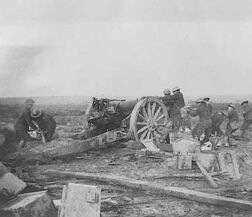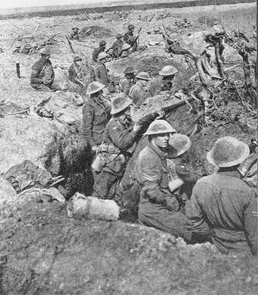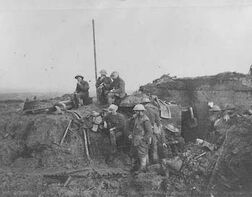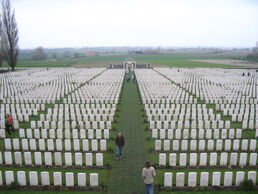|
File: 1008003819 1.jpg Map of the Area of Passchendaele |
The Battle of Passchendaele or the 3rd Battle of Ypres was a battle that had taken place on the village of Passchendaele, though strategically inconclusive, the Battle of Pachendaele was a tactical victory to the allied army, as the Germans had taken unraplaceable losses.
History[]
The official name of the battle is "3rd Battle of Ypres", but is universally known as the Battle of Passchendaele, because it was a series of skirmishes with one goal, taking the village of Passchendaele and the high ground around them. It began on July 31, 1917 with the attack in the northern plains at Pilcken on the left and ravine Gheluvelt at right. The troops would be supported in Pilcken by massive formations of tanks and attack proved initially successful but, unfortunately, the troops of the right flank were blocked and failed to achieve his goal: conquesting the ravine Gheluvelt.
At four o'clock the rain began. The weather remained wet for days and floods on the terrain don't allowed operations with tanks. Although the Field Marshal Sir Douglas Haig had proposed a short battle in order to penetrate the German lines, it was patently impossible now, he still insisted on continuing to Battle of Langemark at north. General Humbert Gough, chosen by Haig as one of the most aggressive of his generals of division, warned Haig that it would be wiser to stop the battle, but the inflexibility of the Commander in Chief of

British field cannon
the Allied Forces decided that it would continue for another three weeks until 26 August, despite the casualties suffered crippling.
Haig decided to shift the focus of the battle for the North East and when the good weather finally arrived, ordering the assault in the ravine itself. He also changed his staff, and General Herbert Plumer was appointed to lead the next offensive. Plumer, one of the most astute British generals, was a staunch advocate of advances in small scale, under the protection of portentous artillery barrages, that would prevent German counterattacks. Such a philosophy would lead to a tremendous concentration of power in a relatively small front, which facilitates the exchange of tired men and the distribution of food and ammunition. Men should go behind the shelter of bullets and the enemy would be obscured by smoke and debris from the barrage, however, this would be impossible if, by chance, it rained and the ground became a mass of mud. The Battle of Menim Road on 20 September, was the first of three famous victories using a new tactic advocated by Plumer. At dawn of day, after a saturation bombing of five days, the Anzacs were able to perform an attack with two victorious Australian divisions side by side and supported by a Scottish division to its left.
The Australians reached the bottom, the Polygon wood, the deed has cost 5,000 casualties to the troops, and then the forest was captured. The land seized was consolidated and backed by a railway line and secondary r

Australian soldiers fighting at Polygon Wood
oads were quickly opened to allow the rapid arrival of new supplies to the front.
On September 26 the weather was still good and the ground had dried up, that day the saturation barrage of Plumer worked well and the Anzacs could proceed under such coverage, very quickly. The 4th Australian Division then took the rest of the Polygon wood area, or what was left of it. They had then reached a position that would strike the main ravine Broodseinde. The Battle of Broodseinde took place at dawn on October 3. Australian troops on standby were bombarded with heavy mortars in their trenches and, as reached the top, were overtaken by German troops advancing under cover of the barrage, by coincidence the enemy troops had launched an assault at the same time. The Germans were eventually driven back by charging with fixed bayonets of Australians, however the German machine guns were causing increasing casualties and retained part of the attack.
After the Australian charge, the Germans retreated to where their trenches where, together with their reserves, they were struck by intensive English artillery, which caused heavy casualties to the Germans. The artillery barrage was directed deep into German lines, and then turned to the Australian position, which, under cover, stepped forward and captured the hill later on October 4, a day described by Ludendorff as "the german black day." As the Australians reached the top of the ravine, has enabled them to see behind German lines just in front, the only obstacle to their success was the occupied village of Passchendaele to the north. Those three wins were credited to the overwhelming success of the technique step-by-step guide on Plumer and were possible only because the weather had been dry enough to allow the mud to dry. But it began to rain on October 5, the next day.
It was not a torrencial rain, but a fine persistent rain. Sir Douglas Haig, however, encouraged by three wins, had ignored the rain and decided to make one more attempt to break the German lines on the mountain, to warn that the cavalry to be ready to follow the rush and start the chase. He ordered t

Australian troops at a captured Bunker
he Anzacs in the taking of Passchendaele on October 9, even with the increase in rainfall intensity. Apparently he did not know the very weak conditions on the ground, that the barbed wire had not been cut and that the Germans had replaced their troops by new men, rested on its "relatively dry" bunkers. His reasons were to continue to allow their troops to winter in the ravine, without which the Germans might be able to target and "drier", once the front line would be beyond the swamp.
The Australians attacked at the August Forest, near Tyne Cot, Captain Clarence Jeffres organized a group and raided one of the bunkers, capturing four machine guns and 35 prisoners. He also led another charge, the next fort, but was killed by shrapnel fire. He was presented the Victoria Cross posthumously. According to Lieutenant John Laffin, all officers in his battalion were killed or wounded that day. Incredibly, and especially the bravery of Captain Jeffres, 20 men reached the wreckage that were part of the church of Passchendaele. Unfortunately the British on the right failed to support them and escort them and the Australians were forced to withdraw for the entire journey, until the slough of their original front line. At this point their artillery was almost out of ammunition and its projectile, when fired, were buried in mud, causing very little impact on the enemy
Haig was still clung to the battle, even with the rain and cold that came on Oct. 12. His crazely has ordered a further assault, which was destined to fail miserably, with men struggling to come up with mud on the heights of their hips and with jammed rifles. This attack cost 7000 casualties to allied forces, only the 3rd Australian Division lost 3,199 men in the first 24 hours of the offensive. The Australians finally fell exhausted, but Haig was pathologically obsessed with the capture of the village of Passchendaele and ordered to Canadians to assume the battle. However the General Elliot, one of the few state-of higher Haig who still had the good sense, refused to move the troops did not improve as time and adequate supplies were not available. Eventually, on November 12, Canadians took Passchendaele, or what remained of the village, and the battle finally ended. Aerial photographs were taken after the battle of Passchendaele, an estimated half a million bullets holes could be seen in half a square mile of the city. It was there that, presumably, Haig hoped that his troops spent the winter. Even reaching the goal, he was useless in terms of the original plan: the attack by sea to Nieuport was abandoned and there were hopes of advancing against the German ports of La Mancha, which were subsequently blocked by the Admiralty through the sinking ship at Zeebrugge.
Casualites[]
Passchendaele cost half a million lives in its three months. The Germans

Tyne Cot Commonwealth War Graves Cemetery and Memorial to the Missing.
lost approximately 250,000 to 400.000 men and the allies lost 300,000 Britons, of whom 36,500 were Australian. 90,000 British or Australian bodies were never identified, 42,000 were never recovered, they were blown to pieces or were submerged in deadly mud. Many of the drowned were exhausted or wounded men who fainted or fell from the boards (placed for crossing the seas of mud) and could not escape the mass, sinking to their deaths as they struggled to survive.
Passchendaele certainly sums up the extraordinary bravery of soldiers who attempted it was obviously impossible, but by superhuman efforts succeeded in fulfilling its objectives. Even though their efforts may be rendered useless by the excesses of the High Command, they should never be minimized or forgotten.
Trivia[]
- In 2003, the British band Iron Maiden paid tribute to the men who died on the battlefields of Passchendaele by recording a song entitled Paschendale. The song is told from the perspective of a soldier who died during the battle. It depicts life in the trenches, and many other experiences soldiers underwent such as getting shot at by machine guns and airplanes.
- Adolf Hitler served in this battle serving at the 6th Bavarian Reserve Division being injured by a gas attack and being outta commission until the end of war.
See also[]
The original article can be found at Battle of Passchendaele and the edit history here.